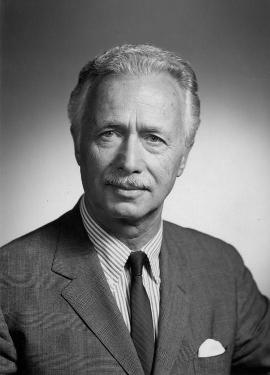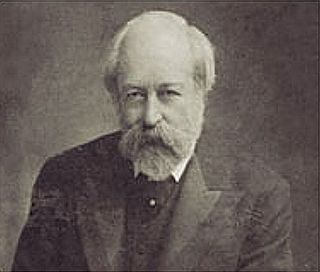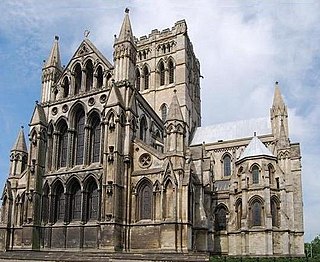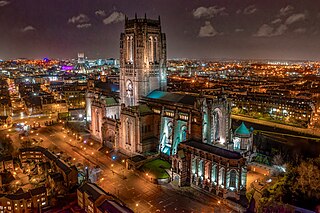
Cass Gilbert was an American architect. An early proponent of skyscrapers, his works include the Woolworth Building, the United States Supreme Court building, the state capitols of Minnesota, Arkansas, and West Virginia, the Detroit Public Library, the Saint Louis Art Museum and Public Library. His public buildings in the Beaux Arts style reflect the optimistic American sense that the nation was heir to Greek democracy, Roman law and Renaissance humanism. Gilbert's achievements were recognized in his lifetime; he served as president of the American Institute of Architects in 1908–09.

Sir George Gilbert Scott, largely known as Sir Gilbert Scott, was a prolific English Gothic Revival architect, chiefly associated with the design, building and renovation of churches and cathedrals, although he started his career as a leading designer of workhouses. Over 800 buildings were designed or altered by him.

Sir Giles Gilbert Scott was a British architect known for his work on the New Bodleian Library, Cambridge University Library, Lady Margaret Hall, Oxford, Battersea Power Station, Liverpool Cathedral, and designing the iconic red telephone box.

Pietro Belluschi was an Italian-American architect. A leading figure in modern architecture, he was responsible for the design of over 1,000 buildings.

The Church of St Margaret, Westminster Abbey is in the grounds of Westminster Abbey on Parliament Square, London, England. It is dedicated to Margaret of Antioch, and forms part of a single World Heritage Site with the Palace of Westminster and Westminster Abbey.

George Frederick Bodley was an English Gothic Revival architect. He was a pupil of Sir George Gilbert Scott, and worked in partnership with Thomas Garner for much of his career. He was one of the founders of Watts & Co.

George Gilbert Scott Jr. was an English architect working in late Gothic and Queen Anne revival styles.
John Oldrid Scott was a British architect.

Liverpool Cathedral is the Cathedral of the Anglican Diocese of Liverpool, built on St James's Mount in Liverpool, and the seat of the Bishop of Liverpool. It may be referred to as the Cathedral Church of Christ in Liverpool or the Cathedral Church of the Risen Christ, Liverpool, being dedicated to Christ 'in especial remembrance of His most glorious Resurrection'. Liverpool Cathedral is the largest cathedral and religious building in Britain, and the eighth largest church in the world.

Burlison and Grylls is an English company who produced stained glass windows from 1868 onwards.
John Birnie Philip was a nineteenth-century English sculptor. Much of his work was carried out for the architect Sir George Gilbert Scott.

Watts & Co. is a prominent architecture and interior design company established in England in 1874. It is a survivor from the Gothic Revival of the nineteenth century: a firm founded in 1874 by three leading late-Victorian church architects – George Frederick Bodley, Thomas Garner and Gilbert Scott the younger – to produce furniture, textiles, stained glass windows, and needlework in a style distinctively their own.

Temple Lushington Moore was an English architect who practised in London but whose work can be seen across England, particularly in the North. He is famous for a series of fine Gothic Revival churches built between about 1890 and 1917 and also restored many churches and designed church fittings. He did some work on domestic properties, and also designed memorial crosses.

St George's Church is a Church of England church on the Isle of Portland, built between 1754 and 1766 to replace St. Andrew's which had fallen into disuse and was no longer suitable as a place of worship.
Edward Bainbridge Copnall was a British sculptor and painter. Best known for his architectural and decorative sculptures featuring allegorical and religious subjects. He was the President of the Royal Society of Sculptors from 1961 to 1966.

St. George's Church is a former parish church in Dublin, Ireland, designed by Francis Johnston, it is considered to be one of his finest works. The structure is located at Hardwicke Place, just north of the city centre, though when it was opened this was considered to be in Drumcondra. The elegant spire, 200 feet (61.0 m) high, became a landmark of the north inner city. Along with St Andrew's Church, Chennai, it is considered one of the finest stylistic "daughter" churches to London's St Martin-in-the-Fields.
Charles Marriott Oldrid Scott was an English architect who is often best remembered for being the son of John Oldrid Scott and grandson of Sir Gilbert Scott, both of whom were architects, as was his uncle George Gilbert Scott Jr. and his cousins Sir Giles Gilbert Scott and Adrian Gilbert Scott. He was married and had two children; Sheila Grace and Helen Baret. After living in central London for some time, he moved to Little Kimble, near Aylesbury, Buckinghamshire.

Queen Anne House is an 18th-century detached house located within the village of Fortuneswell, on the Isle of Portland, Dorset, England. The house, together with its boundary wall and gate piers, has been a Grade II* listed building since May 1993.
Thomas Simpson (1825–1908) was a British architect associated with the seaside town of Brighton. As architect to the Brighton and Preston School Board and the equivalent institution in neighbouring Hove, he designed "a distinguished group of board schools" during the late 19th century, when the provision of mass education was greatly extended. Many of these schools survive and some have listed status. He also worked on five Nonconformist chapels for various Christian denominations, using a wide variety of materials and architectural styles. He was the father of Sir John William Simpson and Gilbert Murray Simpson, who both became architects.

Sir Thomas Duncan Rhind was a Scottish architect and military figure. He was knighted in 1919 for services to his country.















